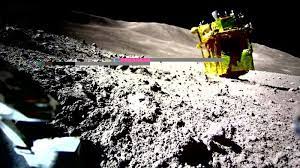The lander was shut down after it touched down, but it has now resumed operations, according to Japan’s space agency, because of a probable shift in the sun’s direction.
Nine days after Japan became the fifth nation to land a spacecraft on the moon, the Japan Aerospace Exploration Agency (JAXA) announced late on Sunday that it had established communication with its lander once more.
On January 20, the Smart Lander for Investigating Moon (SLIM) made landfall on the moon about 55 meters (180 feet) from its intended location. However, due to a possible malfunction with one of the probe’s two primary rockets, the probe fell on its head instead of its feet.
After barely three hours, mission managers were forced to place the lander into slumber as battery power rapidly depleted.
But the probe’s solar panels have managed to produce power because of a shift in the direction of the sun.
According to JAXA, the lander has started up again to examine the composition of olivine rocks on the moon’s surface in an effort to find out more about the moon’s formation.
Although the agency originally stated that the lander was not intended to last a lunar night—the next one is on Thursday—it now stated that it is unclear when SLIM will cease operations.
The mission has already been deemed successful since it succeeded in reaching its main goal of landing inside a target zone with a diameter of 100 meters. This technology has the potential to be extremely useful for future investigation of potential supplies of oxygen, water, and fuel.







